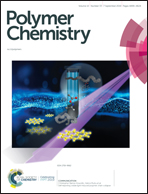Construction and carbon dioxide capture of microporous polymer networks with high surface area based on cross-linkable linear polyimides†
Abstract
Microporous polyimides have been extensively investigated for gas capture and separation applications. Polyimides with intrinsic microporosity with contorted structures exhibit high surface areas. However, except for polyimides with intrinsic microporosity, most linear polyimides do not have microporous structures. Here, a crosslinked structure is introduced into linear polyimides to construct microporous polyimide networks with high surface areas. It is intriguingly found that the surface areas of the microporous polyimide networks increased by about ten times compared with the uncrosslinked polyimides; they are in the range of 635–727 m2 g−1 and among the best reported results for linear polyimides with intrinsic microporosity. TF-PI-CL and 6FA-PI-CL can respectively adsorb 10.03 and 7.28 wt% CO2 (273 K/1 bar). Meanwhile, the CO2/N2 and CO2/CH4 selectivities of TF-PI-CL are 58.4 and 12.9, respectively. This work reveals that the introduction of a crosslinked structure is an effective method of fabricating microporous polyimide networks with high surface area and highly selective CO2 capture capacity based on linear polyimides, which is crucial for CO2 capture and storage.



 Please wait while we load your content...
Please wait while we load your content...